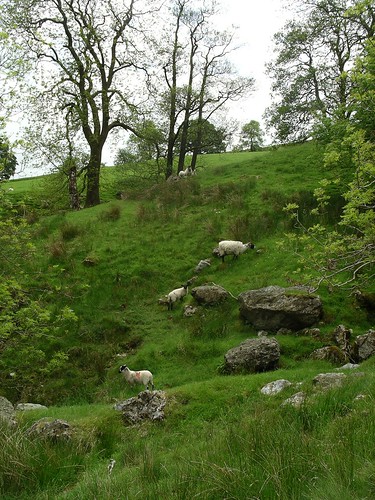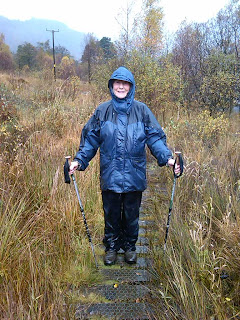- After parking, look for the spectacular 18th century limekiln behind the recreational centre and then walk on to pass, on the left, the lane that continues to Scales. A few steps along, turn left into a track, where you are also invited to park (honesty box). Carry on along the track, once reinforced to carry traffic to the lead mines, with the River Glenderamackin to your left and directly ahead the spectacular nose of The Tongue. Ignore a path that carries on along the side of the river as it winds away below Souther Fell, and follow the wide track that climbs quite steeply at first and then curves round the left side of The Tongue. Across to the left, and towering over Bannerdale Beck as it meanders through it dale, looms Bannerdale Crags.
- Where the path divides at a pile of stones, take the narrower path on the right. The left hand grassy track leads to the old lead mine on the steep slopes of the Crags. The path you need heads straight up the fell, climbing gently all the way. Look out as you go for the first appearance of Blencathra ‘peeping’ over the top of the Crags. After a long delightful grassy climb the path becomes a little eroded and just beyond stands a small cairn. From here the path to the Crags winds left. This walk carries on ahead on an indistinct path, which soon levels and becomes clear as it nears a cross of grassy tracks and paths, marked with a tiny cairn. Turn right and stroll the grassy highway to what seems to be the summit cairn of Bowscale but is in fact a rough semi-circular shelter of rocks. This is the highest point on Bowscale (2300ft/702m) and is very useful for an out-of-the-wind place for your first stop. From here you can see Lonscale Fell, Great Calva and Knott. Then walk on along the flat stony top, where least willow and mountain everlasting struggles to survive, to the cairn, from where the views are superb.
- Return along the grassy swathe and at the cross of tracks, carry on ahead to walk along the rim of Bannerdale Crags (2230ft/683m), all the way to the cairn, a rough slatey affair. Again you will want to pause to enjoy the pleasing views. Then turn right and descend another good grassy swathe towards the col at the right end of Blencathra. Here several paths and tracks meet. Avoid all of these except the good narrow path going ahead onto Mungrisedale Common. A short way along you come to a rather rough shallow gully and the distinct path goes on but this is not the path you need. Climb a few steps out of the gully and then head up the shallow left slope to come to a distinct narrow grassy path (can be boggy after rain) heading gently and almost level, diverging away from the other path across the extensive moorland, for nearly a mile. After a dry spell the path is great but you can see the dried bog plants and on either side some dark pools. As you progress look for pyramidal Great Calva and then Lonscale Fell. Just before the bouldery small cairn (2068ft/633km) with an iron fence post sticking out of it, notice the larger boggy pool round which you wind right. After a pause at the cairn on this rather featureless height, make your return by the same path. There are six or seven paths radiating from the cairn and they all look the same. You will know you are on the correct one when you pass to the left of the boggy pool you noted earlier.
Enjoy the great view of Blencathra as you return across the moor to the col crossed earlier, at the left end of the mountain. Here bear slightly right and then left to reach the start of a path that keeps to the left side of the River Glenderamackin. At first it is rough and a bit scrambly but it rapidly becomes a fine grassy track. Stop as you descend and turn round for a spectacular view of the ‘saddleback’ of the mountain and the very sharp, Sharp Edge. The path descends steadily to White Horse Bent and here you should watch for the narrow grassy footpath dropping down to a wide tractor bridge over the river.
- Beyond climb up the slope, which looks much worse than it really is. At the top wind a little right, with the path and then turn left to another meeting of paths. Curve left to start your gentle ascent of Souther Fell. (1680ft/522km). Where the path divides don’t be tempted to head, left, for the well kept cairn but continue gently climbing to reach the summit, marked by a tiny hump of stones from where you have another glorious view. Now a decision has to be made. The path from the summit goes on pleasingly and then makes a long steepish descent with just a little scrambling. Just before the last drop, a post with a large white arrow directs you right along a steadily descending path, through a wet area and on for well over 1/4 mile to the end of enclosed fields. Wind round the last fence and descend a short way to the road to Scales. Turn left and walk on towards the Mill Inn. Here take a pleasing footbridge over the Glenderamackin to return to the car park.
A much easier return involves returning from the summit cairn of Souther Fell for a 1/4mile. Then a drop down, left, over the pathless slope, keeping to the left of some boggy patches. Ignore the first little path going left and take the next, a slittle further down the slope. At first this is narrow but quite clear. Soon it becomes wider and then it becomes a wide green track, a joy to walk. This route down gives you time to enjoy the glorious flat land below, stretching away to the Pennines. The last 50yds are rather vague but by this time you can see the narrow road, which you should join by the gate across the road. Carry on along the road to arrive at Mill Inn and the wooden bridge across to the car park.
- Start/finish: Small parking area (£2) Mungrisedale village below Mill Inn and opposite the Recreational Centre (GR364303)
- Distance: 9 1/2 miles/15km
- Time: 5 hours
- Height gain: 2051ft/662m
- Terrain: Good walking after dry weather but can be a peaty walk in places after heavy rain
- Map: OS Explorer OL 5 The English Lakes north-eastern area
- Refreshments: Mill Inn, Mungrisdale
View Larger Map
For more photos, see "Walk from Mungrisedale Village" on Flickr.
If you enjoyed this blog post, find more walks by Mary Welsh either by clicking through to take a look at A list of walks in the Lake District or use the search bar in the top left hand of your screen.
Please read Mary Welsh's Golden Rules for good, safe walking before setting out.




